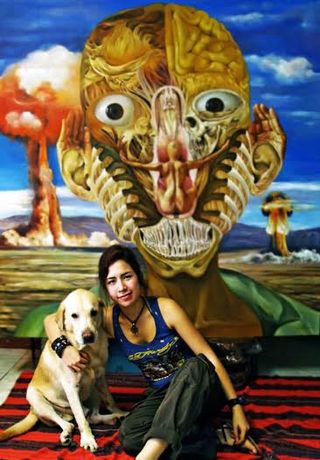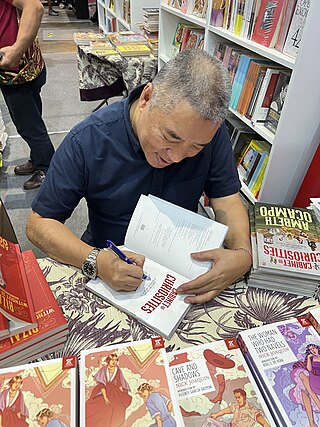Related Research Articles

Metropolitan Manila, commonly shortened to Metro Manila and formally the National Capital Region, is the capital region and largest metropolitan area of the Philippines. Located on the eastern shore of Manila Bay, the region lies between the Central Luzon and Calabarzon regions. Encompassing an area of 636.00 km2 (245.56 sq mi) and with a population of 13,484,462 as of 2020, it is composed of sixteen highly urbanized cities: the capital city, Manila, Caloocan, Las Piñas, Makati, Malabon, Mandaluyong, Marikina, Muntinlupa, Navotas, Parañaque, Pasay, Pasig, Quezon City, San Juan, Taguig, and Valenzuela, along with one independent municipality, Pateros. As the second most populous and the most densely populated region in the Philippines, it ranks as the 9th most populous metropolitan area in Asia and the 6th most populous urban area in the world.

Leandro Valencia Locsin, Sr., also known by the initials LVL and the nickname "Lindy", was a Filipino architect, artist, and interior designer known for his use of concrete, floating volume and simplistic design in his various projects. An avid collector, he was fond of modern painting and Chinese ceramics. He was proclaimed a National Artist of the Philippines for Architecture in 1990 by the late President Corazon C. Aquino.
Eduardo de los Santos Castrillo was a renowned Filipino sculptor.

Ambeth R. Ocampo is a Filipino public historian, academic, cultural administrator, journalist, author, and independent curator. He is best known for his definitive writings about Philippines' national hero José Rizal and on topics in Philippine history and Philippine art through Looking Back, his bi-weekly editorial page column in the Philippine Daily Inquirer.
Onib Olmedo was a Filipino painter acclaimed by critics as one of the major Filipino artists of the 20th century. Olmedo created a body of works that utilizes the expressionist technique of distortion to portray the inner torment experienced by modern man.

Mario Parial was a multi-awarded Filipino painter, printmaker, sculptor and photographer. His works have been sold at Sotheby's.
Anastacio Tanchanco Caedo was a Filipino sculptor. His style of sculpture was classical realist in the tradition of his mentor, Guillermo Tolentino.

Marcel Antonio is a Filipino painter. Considered one of the most promising young talents in Philippine contemporary art while still attending the University of the Philippines' College of Fine Arts in the late 1980s, he launched a solo show and thereafter dropped out of the college to continue to produce collections of his distinctly narrative as well as pseudo-narrative figurative paintings influenced by modernism and 1980s postmodernism. Since then, Antonio produced enough sold-out works to be quickly counted as one of the Philippines' young painters most proficient in the magic realist sort of post-expressionism in the country.

Santiago Apostol Parish Church, commonly known as Betis Church, is a Baroque-style church located in the Betis District of Guagua in Pampanga, Philippines under the Roman Catholic Archdiocese of San Fernando. The church was established in 1607 and dedicated to Saint James the Greater, the Apostle. It was declared a National Cultural Treasure by the National Museum and the National Commission for Culture and the Arts.
Filipino women artists started contributing to Philippine art when the Philippines was still a colonial province of Spain (1521–1898). They have continued to participate as art creators after World War II through modern times by either following the traditional way of making art or by departing from such tradition by embracing modernism and other modes of expressing themselves through art.

Camille Jean Verdelaire D. Dela Rosa is a painter who studied at the University of the Philippines, Diliman. Her works, commencing in 1998, include Impressionist gardens, landscapes, churches, beaches, and morbid surrealisms.

Abdulmari Asia Imao was a Filipino painter and sculptor. Imao was named National Artist of the Philippines for Visual Arts in 2006. A Tausūg, Imao is the first Moro to receive the recognition. Aside from being a sculptor, Imao is also a painter, photographer, ceramist, cultural researcher, documentary film maker, writer, and a patron of Philippine Muslim art and culture.

The following outline is provided as an overview of and topical guide to Metro Manila:
Roy Santos Veneracion is a Filipino painter whose work explores a wide range of styles, techniques, materials, and subject matter. He is considered one of the leading abstract artists in the Philippines and the precursor of contemporary Aesthetic Syncretism. His work is associated with the Syncretism art movement in the Philippines and abroad.

Jaime C. Velasquez Park, commonly referred to as Salcedo Park, is a pocket park in Makati, Metro Manila, the Philippines. It is one of four pockets of greenery located in the central business district within Salcedo Village in barangay Bel-Air. The park is the site of a popular weekend market called the Salcedo Community Market. It is also the main venue of the bi-annual contemporary art fair called Art in the Park.

Ramon Nazareth Villegas more popularly known as Mon Villegas or Boy Villegas, was a Filipino curator, art historian, jeweler, author, antiquities dealer, and poet. He was best known for chronicling the history of Philippine art and antiquities in various publications in both the Philippines and overseas. Villegas ran his own antique shop called Yamang Katutubo Artifacts and Crafts, which featured Philippine jewelry and antiques that closed on his death in 2017.
Ofelia Gelvezon-Tequi is a Filipina visual artist based in France. She works primarily in the media of painting and printmaking and is considered a pioneer in Philippine printmaking. Her prints are created using copper-plate etching and viscosity color printing techniques.

The bibliography of Philippine historian Ambeth Ocampo is a list of approximately more than one hundred works which the historian has written, co-written, edited, and includes works for which he has written a foreword, introduction or afterword.
References
- 1 2 3 4 5 "Claude Tayag: About Claude". Bale Dutung. 2013. Retrieved 26 April 2018.
- 1 2 Pilar, Santiago Albano (1994), CCP Encyclopedia of Philippine Art (First ed.), Manila: Cultural Center of the Philippines, ISBN 9789718546383
- ↑ Gelvezon-Tequi, Ofelia (2011), Vintage Vitalis: Paintings and Drawings (1930–1965), Makati: Alliance Française de Manille
- ↑ Paras-Perez, Rod. (1981), The Moriones Unmasked, Mandaluyong: Galerie Domenique
- ↑ Wood: Sculptures and Furniture in Wood by Claude R. Tayag, Mandaluyong: SM Megamall, 1997
- ↑ "Rediscovering Macario Vitalis the road less taken". The Philippine Star . 27 February 2011. Retrieved 26 April 2018.